Design and Implementation of National Meteorological Service Platform
, , ,
National Meteorological Information Center, Beijing 100081, China
1 Introduction
With the rapid development of meteorological services, the new exploration data are widely used, the timeliness and spatial resolution of numerical forecast products get higher and higher, and there is an urgent demand for sharing and service of service products. Various service units within meteorological system integrate core service-oriented product resources and internal information resources, start to build internal "service network" system[1-3], and achieve initial results. National Meteorological Center builds the weather service network system oriented for live monitoring, forecasting and disaster warning. With the construction of service network system in various units of China Meteorological Administration, the service product integration level and service sharing level are improved significantly, but the integration of service systems and platforms is still inadequate, there is redundant construction in IT resources, and the service channel is scattered, lacking unified service product sharing platform, resulting in inefficient service and "information island" phenomenon. In addition, there are still some gaps between the national service guidance and the actual needs, and the communication and interaction mechanism construction has just started, never forming an integrated service system layout based on wide area network. For these reasons, China Meteorological Administration develops the construction tasks of NMSP (National Meteorological Service Platform), namely "integrating service product resources of related service units, establishing intensive data environment, and providing a sharing platform by which users can browse, search and view live monitoring, forecasting, early warning information, historical climate data and information networks". After nearly three years of development, the construction of NMSP has achieved initial results, and the system integrates various kinds of key products and services related to meteorology, climate, and information networks. Based on the current construction situation of NMSP, in terms of functional needs, functional realization and application effect, this paper elaborates the current results and subsequent development goals.
2 Functional needs
2.1MeteorologicaldataserviceneedsThe meteorological data services are mainly for the service users of meteorological departments at national, provincial, municipal and county level, as well as the leadership of meteorological departments at all levels. The service staff can view the latest meteorological data, data files and visualization products on NMSP according to demand within authority scope. They can also search and download the real-time and historical weather data to meet the needs of service staff at different levels in different units for weather forecast, climate monitoring and meteorological service.
2.2DatavisualizationneedsThe meteorological data visualization mainly employs meteorological data analysis and image processing technology, combined with GIS geographic information, to provide the users with online statistical services and data visualization services. By means of data visualization, the users can obtain a more comprehensive picture of meteorological data.
2.3ServiceinformationmanagementneedsThere is a need to establish information transmission channels and full-featured service management platform, and provide all levels of service management departments with online information services, statistical analysis and decision support around data management and application service, including the data collection at home and abroad, service transmission quality reporting and high-performance computing resource management, service technical documentation, online meeting and service progress information.
3 Software framework
Based on the application characteristics of the national meteorological service network system (version 2.0), the technology roadmap of the software design is reflected in the following aspects: (i) using B/S framework to design[4-5], conducting integration of service and data resources based on SOA framework system of J2EE, and applying the multi-layer system framework, to ensure top-down reasonable function decomposition and achieve high internal cohesion and low coupling of design units; (ii) using component in conjunction with the plug-in mechanism for design and development, to ensure powerful system, flexible scalability, maintainability and integration; (iii) using parallel processing and load balancing technology, to ensure the high concurrent processing efficiency of multiple data; (iv) using XML data encapsulation technology, to realize flexible process configuration; (v) using relational databases combined with file systems, and performing efficient data storage and management and unified data support service based on characteristics of different meteorological data; (vi) using HTTP, TCP/IP communication protocol, WebService and other communication technologies to achieve communication between components, control data transmission accuracy and timeliness, and ensure data transmission speed on the Internet; (vii) using portal technology to integrate the shared data and product services, meet the needs for information integration, personalization and customization, achieve intensive and personalized meteorological data services for different users, and ensure scalability of data sharing services.
The underlying data of NMSP comprises the following four aspects: (i) structured and unstructured data acquired based on API interface; (ii) structured meteorological data acquired based on database; (iii) file data acquired based on FTP server; (iv) other data except meteorological data, including service materials, specification documents, training videos, and software update package. In framework design, taking into account the characteristics of NMSP support data, based on common J2EE application framework (Struts+ Spring+ Hibernate)[6-7], the control layer, service layer, model layer and data layer are encapsulated, and the data sources, acquisition frequency and acquisition mode are configured in the configuration interface in order to obtain the desired data by developing ID ways. The whole development process focuses more on the front end display page, and considers the user experience needs. The backend data sources and even the data structure changes can be quickly adjusted by one-button configuration, so as to respond effectively to diverse meteorological data.

Fig.1Frameworkcomparison
4 Functions and application effect
4.1Functions
4.1.1Live observation section. It realizes the visualization of 10 major categories (such as ground, air, radiation, agricultural meteorology, sea, radar, satellite) and 50 subcategories of observational data from CMA Observation Center, National Satellite Meteorology Center, China National Environmental Monitoring Center and Ministry of Water Resources.
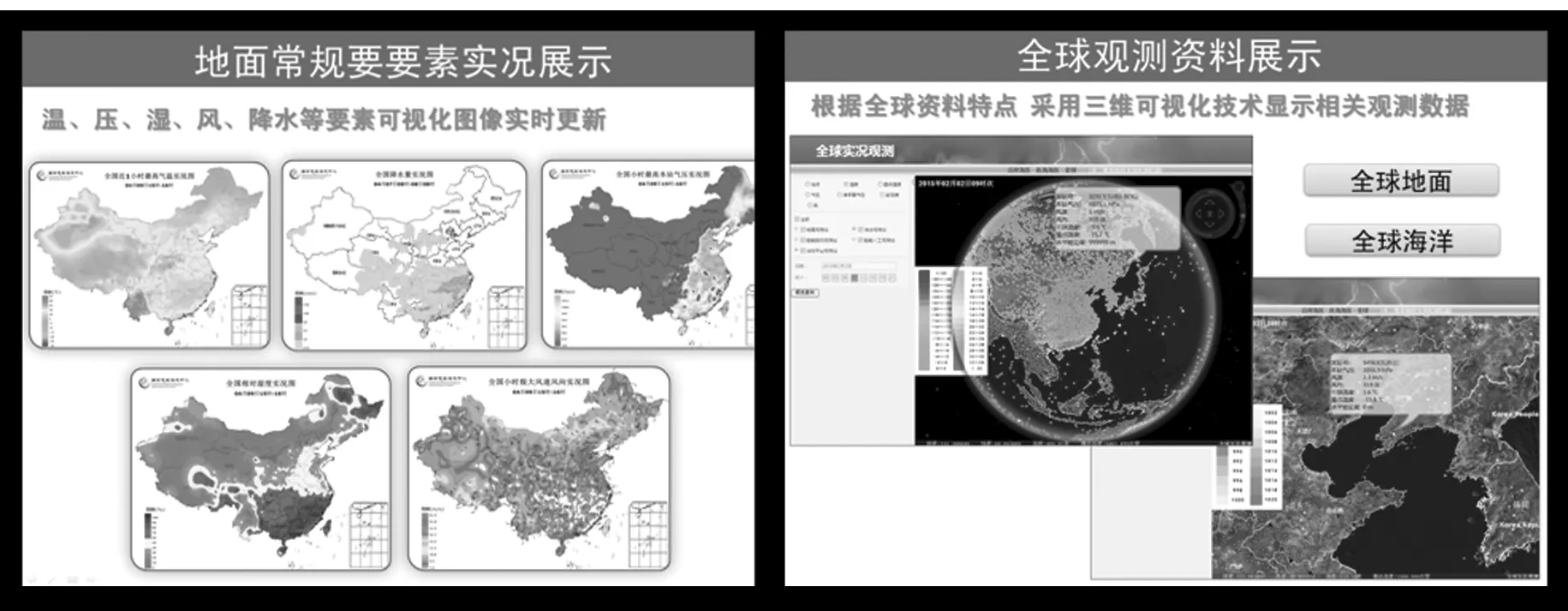
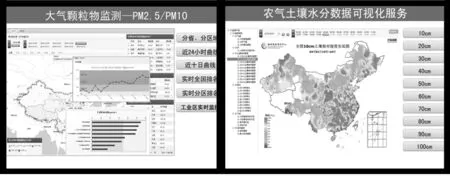
Fig.2Screenshotofliveobservationsection
4.1.2Climate service section. It realizes the release and visualization display of main service products related to climate detection, weather forecasting, impact assessment, climate change, weather patterns and climate services from National Climate Center. Meanwhile, in order to improve the climate service efficiency, for the relevant reporting content submitted via documentation, it realizes the online reporting function based on service network while enabling automatic online format checking of reporting results, thereby improving reporting efficiency.
4.1.3Weather service section. It realizes visualization display of the main forecast products of National Meteorological Center. According to the time scale, it covers long-term forecast, short-term forecast and nowcasting products. According to forecast ways, it covers subjective forecast, and objective forecast products. Special section is established to provide services concerning disaster warning and decisions.

Fig.3Screenshotofclimateservicesection

Fig.4Screenshotofweatherservicesection
4.1.4Weather modification section. It realizes the visualization display of the main forecasting and testing products of weather modification center. The forecasting products include GRAPES_CAMS model products, MM5_CAMS model products and other products; the testing products include ground-based observation and satellite-derived products.
4.1.5Data service section. It realizes the online services for the Chinese and global data products collected, organized and made by the information center, covering ground, air, ocean, radiation, agricultural meteorology, numerical prediction, atmospheric composition, radar, satellite, meteorological services and products, historical climate proxy data, meteorological disaster and climate products. It provides data classification navigation, positioning, data retrieval and downloading, and data interface services.
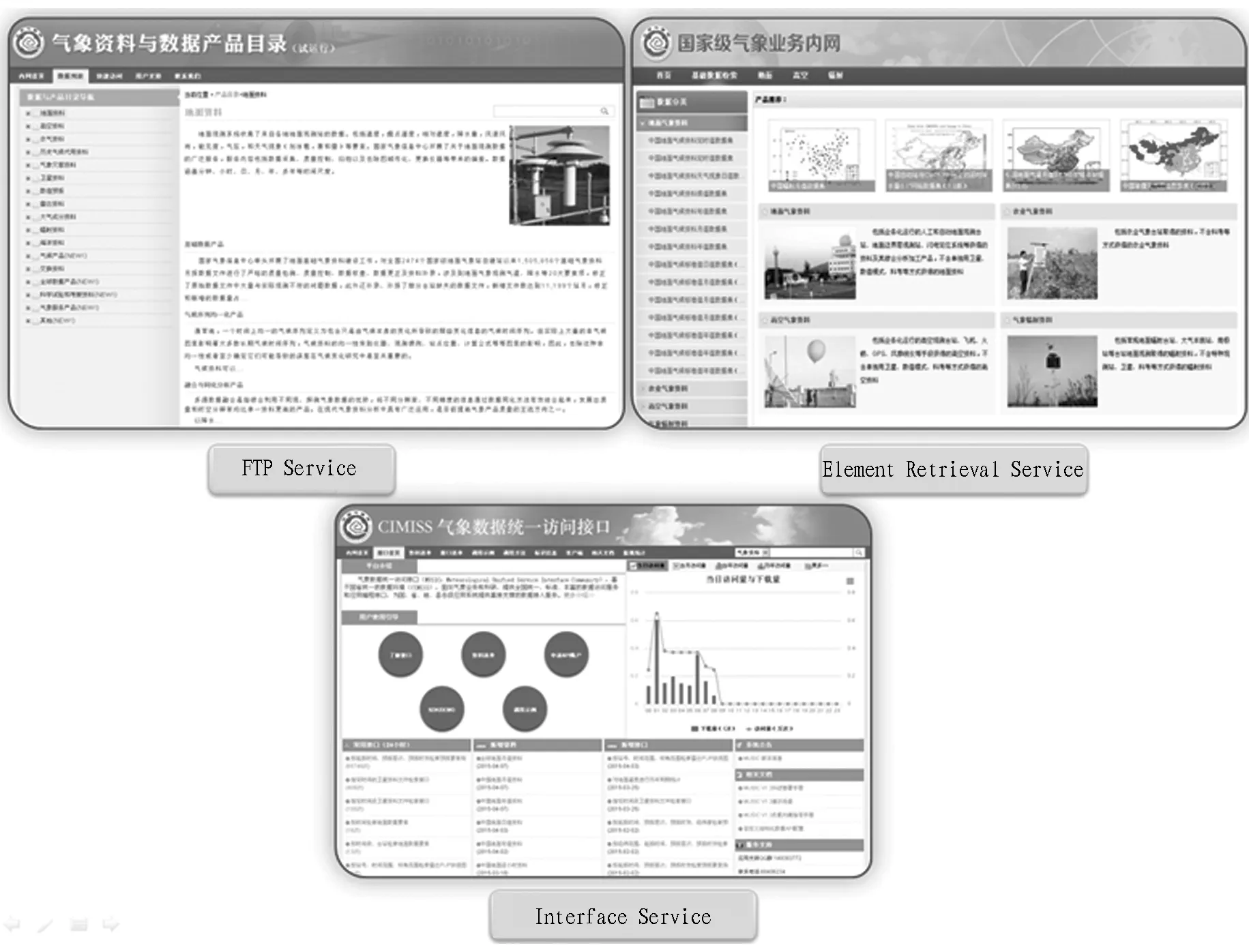
Fig.5Screenshotofdataservicesection
4.1.6Service management section. It establishes top-down information channels and full-featured service management platform, to provide online information services, statistical analysis and decision support for all levels of service management departments around data management and application service, including the collection of global and Chinese data, service transmission quality reporting, and high-performance computing resource management, service technical documentation, and online meeting and service progress.
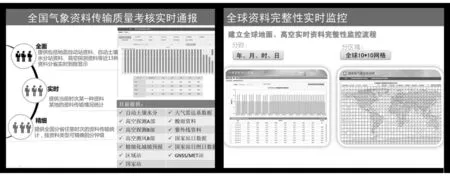
Fig.6Screenshotofservicemanagementsection
4.2ApplicationeffectNMSP was launched in July 2012, and NMSP 1.0 service went on trial operation in May 2013. After five-version upgrade, the version 2.0 went on formal run in March 2015. Currently, NMSP includes include 6 sections (live observation, weather service, climate service, weather modification, data service, and service management) and nearly 100 sub-modules, covering more than 2000 kinds of service products from exploration center, satellite center, meteorological center, climate center, weather modification center and information center. There are more than 20 TB of data resources, and more than 8000 national and provincial core service users. The distribution of NMSP users from different units is shown in Fig. 7.
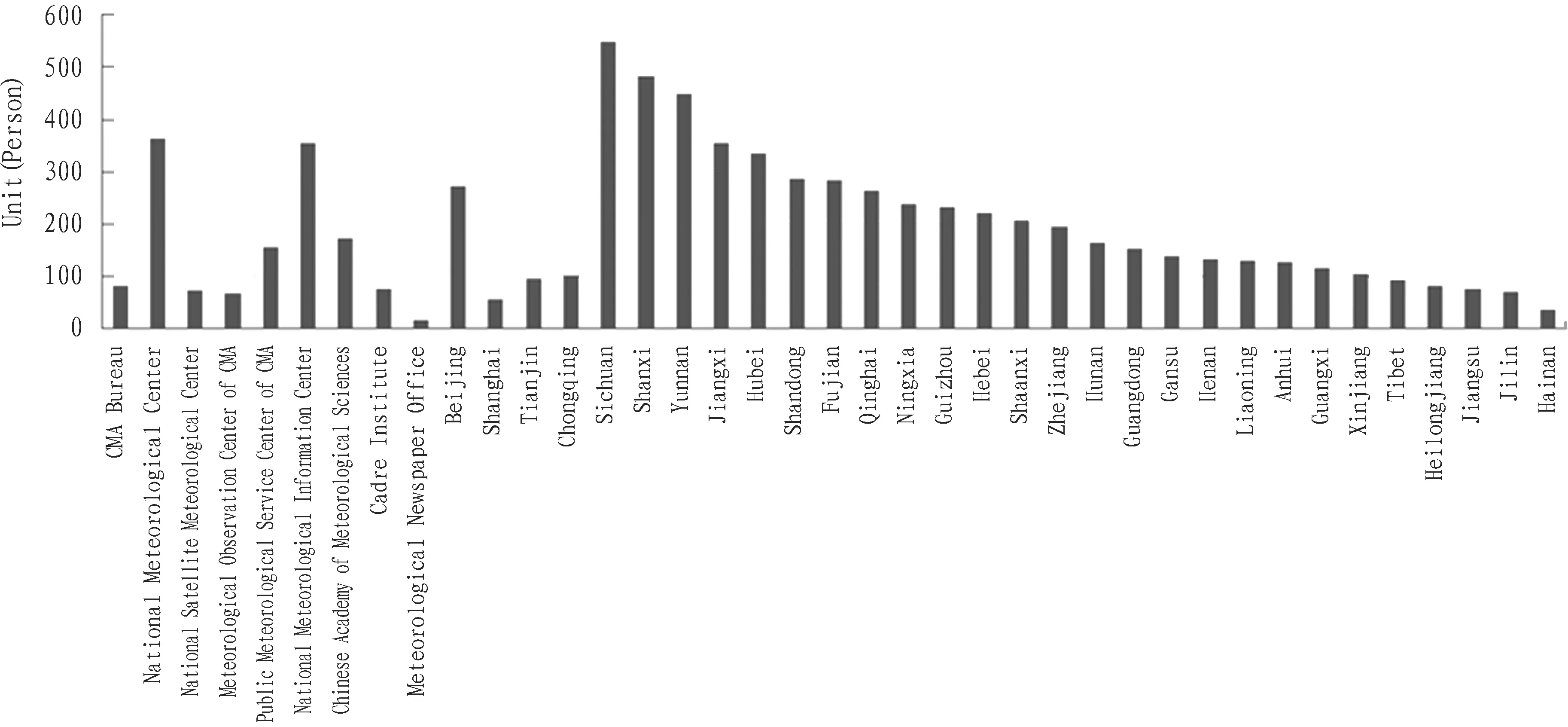
Fig.7ThenumberofNMSPusersfromdifferentunits
5 Conclusions
NMSP is not just a website, and it is a service support platform combined with MICAPS, CIPAS and other professional meteorological service platforms to provide service users with one-stop product view, data acquisition and service management support. At the same time, NMSP is an important support platform for the national units to guide the local units and improve the "top-down interaction" mechanism, and is an important part of national meteorological service modernization. NMSP construction work is in a process of continuous improvement with the development of meteorological services. With the application of cloud computing and big data technology, NMSP will continue to enhance its service support capability, and effectively improve efficiency of meteorological services.
[1] ZHANG YW, DONG XY. A open platform of massive user-oriented meteorological data [J]. Meteorological Science and Technology, 2015(6):1070-1073. (in Chinese).
[2] WU HP, LUO B, WANG WG,etal. Application of geographic information system to decision-making meteorological service system [J]. Quarterly Journal of Applied Meteorology, 2008(3): 380-384. (in Chinese).
[3] LI DQ, ZHOU Y, YU HY. Design and implementation of Beijing olympic meteorology forecasting product service system [J]. Quarterly Journal of Applied Meteorology, 2010(3): 372-378. (in Chinese).
[4] LEI SK, LIU HY, ZHANG XF. Overall design and implementation of provincial public weather service system [J]. Meteorological Science and Technology, 2015(2): 216-220. (in Chinese).
[5] ZHANG YW, DONG XY. A open platform of massive user-oriented meteorological data [J]. Meteorological Science and Technology, 2015(6): 1070-1073. (in Chinese).
[6] HU QM, XUE JY, ZHONG LH. Lightweight J2EE architecture based on spring framework and its application [J]. Computer Engineering and Applications, 2008(5): 115-118, 133. (in Chinese).
[7] LIN B, ZHOU MH, LIU TC,etal. A Web container integration framework in J2EE application servers [J]. Journal of Software, 2006(5): 1195-1203.(in Chinese).
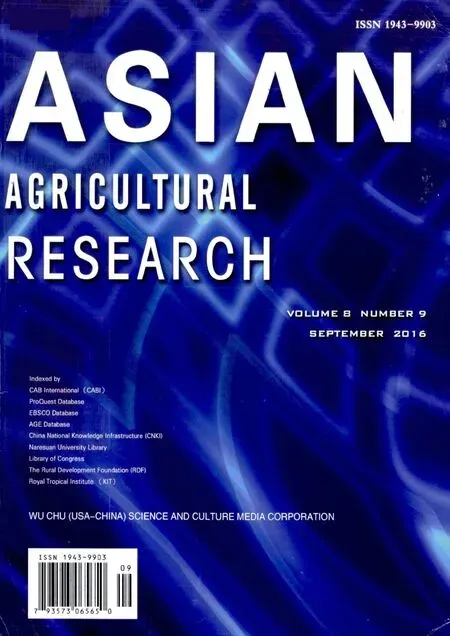 Asian Agricultural Research2016年9期
Asian Agricultural Research2016年9期
- Asian Agricultural Research的其它文章
- Empirical Study on the Relationship between Organizational Flexibility and Performance of Agricultural Enterprise
- Correlation between Employment Quality and Skill Training of Land-expropriated Farmers
- A Study on Spatial Distribution of Commercial Housing Prices in Xiangtan City
- Design and Experiment of Fluid Dynamic Ultrasonic Water Aerator
- The Relation between Age Structure of Population and Resident Consumption Based on Endogenous Growth Theory
- Effect of Different Pretreatments on Explosion Puffing Drying of Hami Melon at Modified Temperature and Pressure in Xinjiang
